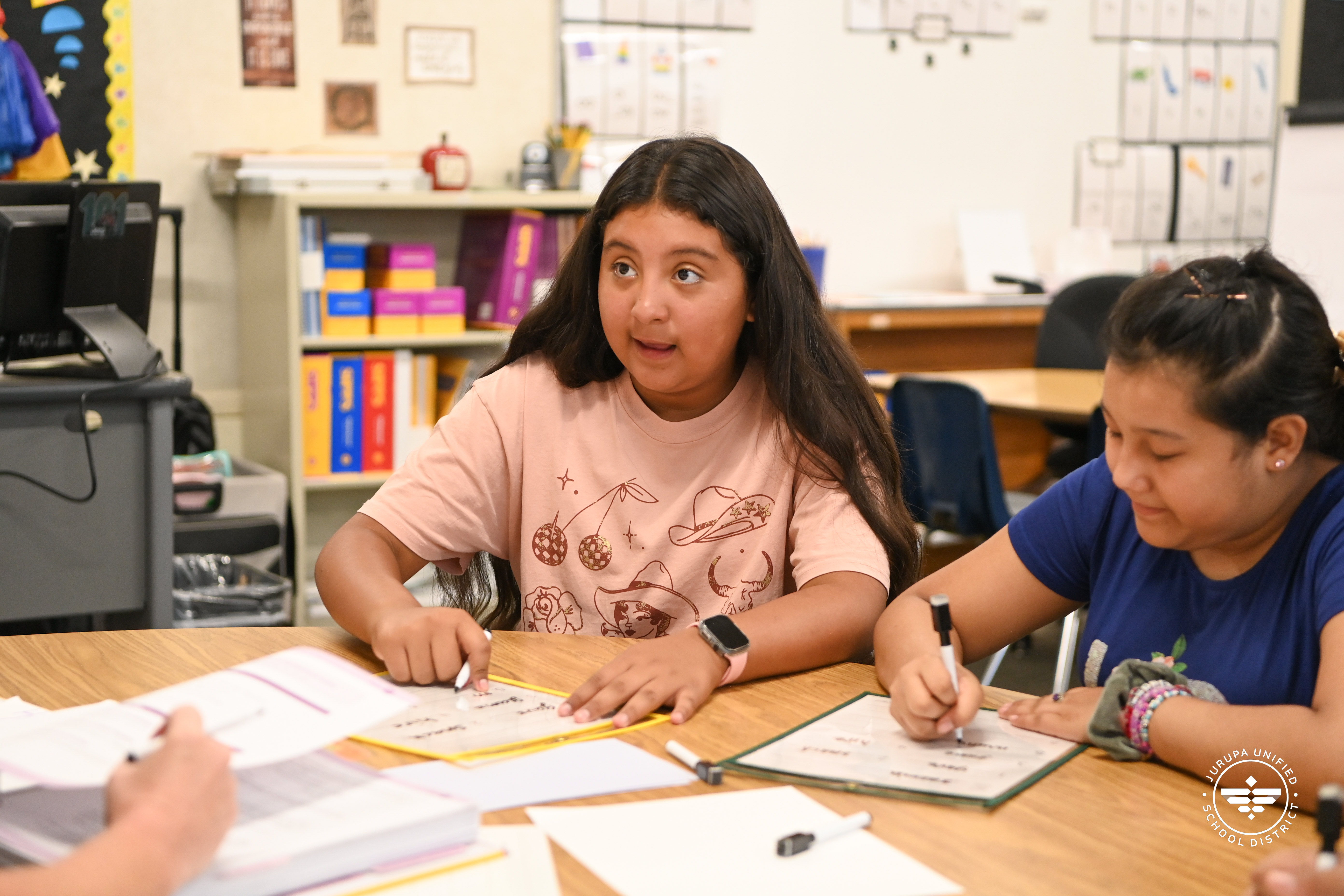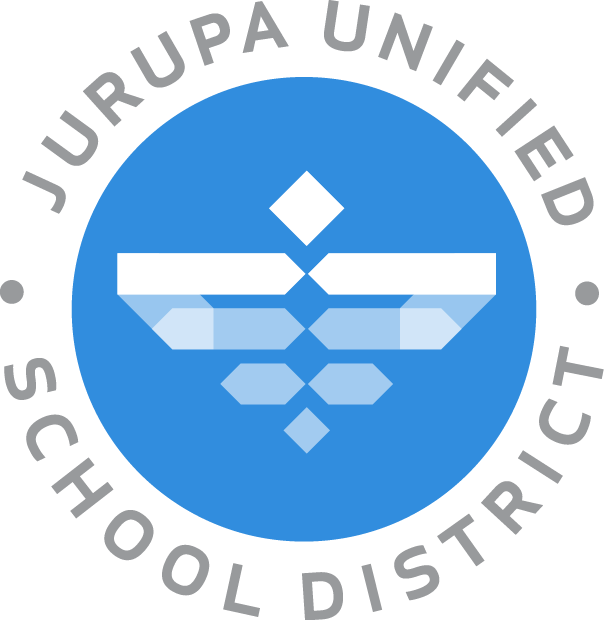Ms. Ciesla recalls how one student who “was really struggling,” found her way by using research-based literacy techniques.
.jpg) “She realized, ‘Okay, it’s not a guessing game….it follows patterns and rules’,” Ciesla said. “Her mindset changed. She went from a kind of unhappy student to just really loving school.”
“She realized, ‘Okay, it’s not a guessing game….it follows patterns and rules’,” Ciesla said. “Her mindset changed. She went from a kind of unhappy student to just really loving school.”
Those “ah-ha” moments occur daily at Jurupa Unified schools as educators help students connect the pieces in the complicated puzzle of interconnected skills that lead to reading fluency. The “science of reading,” includes a body of research that studies how individuals learn to read and how best to teach students.
Reading fluency takes a variety of different skills. Readers must be able to identify letter combinations and what they look and sound like. They must understand phonics and letter sound blends. They need to understand word origins and build their vocabularies, and then they need to practice their skills through guided reading and writing practice.
“A lot of what we’re doing in Jurupa right now we’re deeming as structured literacy,” said Ron Zahnd, Director of Elementary Education, adding that literacy instruction is consistent and paced in a precise way to help students build on their learning.
 “They’ll learn letter sounds, short words, and then that will evolve into… fluency, reading comprehension, writing, and all of those things joined together to create a really well-rounded, literate student…If we truly want to reach more students, we need to have a very explicit approach and sequence to how we’re teaching reading to our kids….Students cannot simply skip from knowing the sounds to… reading fluently,” he said.
“They’ll learn letter sounds, short words, and then that will evolve into… fluency, reading comprehension, writing, and all of those things joined together to create a really well-rounded, literate student…If we truly want to reach more students, we need to have a very explicit approach and sequence to how we’re teaching reading to our kids….Students cannot simply skip from knowing the sounds to… reading fluently,” he said.
But that doesn’t mean lessons aren’t fun.
On a recent August afternoon in Alyssa Morales’ first-grade classroom at Peralta Elementary School, students sat attentively on the carpet as they listened to the tale of The Recess Queen, a story about a playground bully named Mean Jean and how she learned to be a better friend. As they listened to the story, students were asked to think about the characters, the setting, the problem, and the solution. They then used hand movements to show the story components. By understanding these story elements students are building important reading skills that will lead to better comprehension, Ms. Morales said.
“It’s just jumping into the book and understanding the different elements of it,” she said. “Once they understand who’s in the story, they can start understanding what is the problem they’re going through, how do they solve it, and it's nice to be able to apply it to our real lives.”
Ms. Morales’ classroom is filled with elements of literacy – such as a “sound wall” and posters that include fun characters demonstrating how various letter and letter combinations sound. The combination of support and skill reinforcement helps students learn to read with confidence.
“It’s incredible when it clicks and you see it,” Ms. Morales said.
.jpg) At Pedley Elementary, teachers use
Systematic Instruction in Phonological Awareness, Phonics, and Sight Words (SIPPS) with students. Every student in grades K-3 receives small-group reading instruction for two hours each week. Upper-grade students needing more literacy support also receive small group instruction.
At Pedley Elementary, teachers use
Systematic Instruction in Phonological Awareness, Phonics, and Sight Words (SIPPS) with students. Every student in grades K-3 receives small-group reading instruction for two hours each week. Upper-grade students needing more literacy support also receive small group instruction.
That consistent repetition makes a difference, Ms. Ciesla said.
“It hits their different skills..they’re going to be hearing sounds, speaking sounds, reading and writing those sounds and words also. The strength is in the routine. Their brain isn’t trying to learn something new every day. It’s learning the words and the sounds, not the routines.”
“It’s very important, especially with our primary students. This is…where they’re getting their reading basics…if they can all be in a group at their level and then work from that level forward, they’ll just keep progressing in their reading skills,” she said.
Reinforcement at home also is essential, teachers say.
Parents can help by “just reading, reading with their kid. It’s really as simple as that. If they want to dig deeper, it’s talking about the characters, talking about what’s happening in the story. Just being read to …is super important for kids….especially in the younger grades,” Ms. Morales said.
Reading together can mean sharing stories in books, but it can also mean reading the language all around us – street signs, labels in the grocery store, magazine articles, or even recipes.
“We know that reading to and with a child is very important,” Ms. Ciesla said. “It’s hard to schedule that in….they really can take little minutes here and there and then those minutes add up.”
.jpg) To help with access to books, the school’s library is also open before and after school and parents can check out books to share with their students at home. Ms. Ciesla also suggests having reading materials available in the “three B places – bathroom, breakfast table, and back seat” so that students always have access to something to read.
To help with access to books, the school’s library is also open before and after school and parents can check out books to share with their students at home. Ms. Ciesla also suggests having reading materials available in the “three B places – bathroom, breakfast table, and back seat” so that students always have access to something to read.
Since literacy is essential to academic and life success, it’s important for teachers and parents to work together to support students as they master this essential skill.
“Literacy is important for every student because it truly is a gateway skill,” Mr. Zahnd said. “It unlocks every subject area they are going to be exposed to. In any walk of life, the need to be able to listen, read, write, and speak is incredibly important.”

